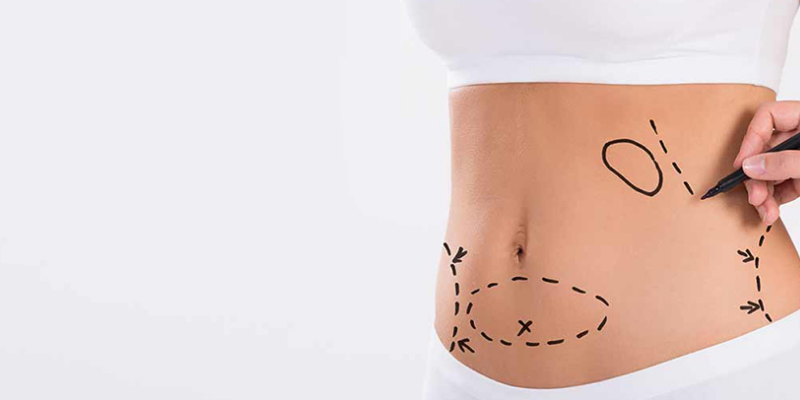Liposuction Weight Loss
With liposuction weight loss, we absorb the fat cells rather than the excess fat in the body. Because the number of fat cells in a person’s body does not alter after puberty. The number of fat cells in the body controls where the extra fat that accumulates as a result of weight gain is stored. If the number of fat cells in your stomach is higher than in other parts of your body, for example, excess fat will gather in these cells. However, there are potential risks to liposuction. The following is a list of the most hazardous yet fortunately rare threats.
Liposuction weight loss reduces the number of fat cells in the body and stops fat from forming in specific areas. In other words, even though the quantity of fat cells in the individual’s belly area is halve as a result of the fat removal treatment, the person’s navel body type is not the same as before.
In Which Cases Is Liposuction Necessary?
Liposuction weight loss is a surgical procedure that removes extra fat from the body’s specific locations. In non-standard conditions such as pregnancy and continuous weight gain, the application’s outcome is unlikely to be long-lasting. Because post-partum skin sagging and cellulite are not diseases that may be cure with liposuction surgery. Although liposuction cannot completely prevent cellulite from forming, the fact that it is perform close to the skin’s surface provides for a more flat appearance.
Additionally, skin drooping, which occurs in people who gain and lose weight often, is a sort of body injury that liposuction cannot fix. If liposuction is to be utilize on patients with this body shape, tummy tucks and sagging skin removal operations should be done as well. To maintain the beautiful appearance acquire over years, a person must control his dietary habits and incorporate exercise into his daily routine of disregard. It has been shown that as different methods of liposuction surgery become more advance, so do the regions of application. Body contouring can be accomplish in a variety of ways, including tightening the skin and removing the sebaceous glands.
The Liposuction Weight Loss Surgery Procedure
On average, liposuction surgery takes between 1-3 hours. Depending on the examination and patient complaints, our surgeons may opt to take varied amounts of oil, but the amount regarded medically adequate is usually between 2.5 and 4.5 liters every day. Prior to the application, our specialists will mark the area you want to contour and where fat will be removed. Before the operation, we can take a photo to visualize the outcome more clearly. Then, depending on your preference, we administer a general or local anesthetic. The combined liquid solution is injected into the area to relieve pain in the area where it will be used.
This liquid contains Lidocaine, a pain reliever, Epinephrine, a blood artery constrictor that inhibits bleeding, physiological serum, and bicarbonate. This procedure numbs and hardens the area, allowing for a more comfortable application. After creating 1-2 mm incisions into the skin, the cannulas are insert on the oily area. The vacuum machine, to which the cannulas are link, absorbs the relatively liquid oil. We use the vacuum tube to break up the oil and allow it to drain as quickly as feasible. To prevent fluid from draining and edema from accumulating, we leave the incisions expose for a brief time following surgery. We stitch the cuts after the operation is finishing.
The Healing Process Starts After Liposuction Weight Loss
We keep our patients in the hospital for one night after the operation and then discharge them the following day. You should wear the bandages we apply immediately following the treatment for 4 weeks or more, depending on the characteristics of the body area where we remove the fat. To avoid edema and bruising, you must adhere to our doctor’s instructions to the letter. The patient can normally resume work and social activities within a few days of the procedure. Edema production must be decrease and a high degree of recovery must be achieve for activities that require high levels of performance, such as exercise. Full Body Liposuction Cost
Getting enough of rest, drinking plenty of water, and avoiding alcohol and cigarettes are all important during the healing process. These treatments aid in the speeding up and easing of the healing process. Antibiotics and pain relievers can be use with a doctor’s consent to hasten recovery and limit the risk of infection. A balance diet rich in vegetables, fiber foods, and low-fat proteins should be follow to ensure that the operation’s impact lasts and that the application area does not get lubricate again. Liposuction Before and After
Liposuction Using Ultrasonic Technology
In order to reach the area to be operate on in this treatment, tiny tubes use in surgery are first employe. Ultrasonic vibrations soften the fat cells in this area, allowing them to be absorbe more easily. After the softening phase, conventional treatments are apply to finish the liposuction procedure.
Laser-assist liposuction Laser beams sent through 2-3 mm fibercannulas to the extra fat cells in the operation region, changing them from solid to liquid. The absorption operation is then perform using thin cannulas that are insert beneath the skin through a millimeter-size incision. Postoperative scarring is not an issue with these cannulas because they are thinner than those use in standard procedures. When we look at liposuction reviews in Turkey, we see that our patients agree.
The Wet Method is a technique that is use to create a wet environment (Tumescent Technique) Liposuction. We employ the “wet approach” in most liposuction reviews in Turkey. We fill the fat cells in the afflict area with fluid and inflate them before executing the suction process. One of the chemicals in the fluids we fill is adrenaline, which stops bleeding and lidocaine, which decreases pain. After the relevant fat cells have been fill defluids, thin tubes with a diameter of 2-6 mm extending beneath the skin from the incisions made on the skin reach the cells.
Breast Reduction Surgery: Reasons to Get it
In understanding the reasons to go under breast reduction surgery, there are some things to consider. Reducing your breasts may improve your life quality, allowing you to exercise more easily or relieve pain in your upper back. It is an invasive procedure making incisions in your skin. However, it leads to smaller, heavier breasts that are less likely to impact your physical comfort negatively. The surgery also has the power to improve your breasts’ shape.

Types of Procedures
After telling you your options, a surgeon may develop a treatment plan tailored to your needs. It may either be an Inverted-T (“anchor”) reduction or Liposuction. If you want a slight breast reduction only, a surgeon may recommend liposuction, which is less invasive and involves fat removal. Liposuction isn’t usually recommended if you have too much sagging, asymmetry, or fatty tissues. A combined breast lift and augmentation may also be used for aesthetic purposes. The answer to the question, does insurance cover breast reduction surgery? It depends on why you are receiving the procedure. A few different types of breast reduction surgery exist. The type of surgery you choose will also affect the overall cost. Insurance may cover some of the breast reduction surgery costs if you have insurance.



